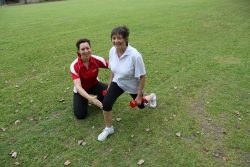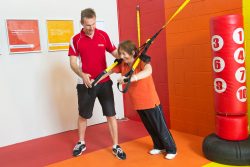 Only around one in 10 Australians over the age of 50 exercises enough to gain health benefits. Some studies suggest that about half of the physical decline associated with aging may be due to a lack of physical activity. It has been suggested that people over the age of 65, more than any other age group, require strength and fitness to help them maintain independence, recover from illness and reduce their risk of chronic disease. Many people worry about starting exercise once they reach a certain point, because they think they are ‘too old’ to start. The truth is; it’s NEVER too late. Every single time you exercise you are doing good for your mind and body.
Only around one in 10 Australians over the age of 50 exercises enough to gain health benefits. Some studies suggest that about half of the physical decline associated with aging may be due to a lack of physical activity. It has been suggested that people over the age of 65, more than any other age group, require strength and fitness to help them maintain independence, recover from illness and reduce their risk of chronic disease. Many people worry about starting exercise once they reach a certain point, because they think they are ‘too old’ to start. The truth is; it’s NEVER too late. Every single time you exercise you are doing good for your mind and body.
Changes with Age
It’s a normal part of the aging process for parts of the body to not work as well as they used to. Some of the most common issues that can arise with age include
- Reduced cardiovascular capacity
- Reduced muscle mass
- Increased percentage of body fat
- Decreased muscle strength and endurance
- Reduced balance and agility
- Increased risk of slips, trips and falls
- Increased recovery time from injuries
- Chronic pain, muscle stiffness/tightness
- Reduced flexibility and range of motion
- Reduced bone density
- Increased risk of chronic disease including heart disease, stroke, hypertension and osteoporosis
Exercise is so important when it comes to maintaining strength, independence, agility and mental health as we get older. This doesn’t mean that you need to train for a marathon or start a bodybuilding program. It just means forgetting your excuses and incorporating physical activity into your lifestyle on a daily basis.
Benefits of Exercise
Regular exercise, particularly exercise combining strength/resistance training with cardiovascular conditioning can help with a whole host of age related issues. Some of the benefits of exercise include
- Increase muscle strength and endurance
- Increased joint strength and stability
- Increased balance – reduction in slips and falls
- Improved self-esteem and self-confidence
- Improved sleep quality and patterns
- Reduced stress and anxiety
- Reduced risk of degenerative cognitive disease like Alzheimer’s
- Improved brain function, learning and memory
- Improved arthritis symptoms
- Improved mood, reduced risk of depression
- Increased energy levels
- Reduced risk of type 2 diabetes, and management of blood sugar levels
- Reduced risk of cardiovascular disease, heart attack and stroke
- Reduced risk of certain types of cancer
It can be a bit scary to start exercising – you might be afraid of hurting yourself, or just afraid that you won’t be able to do it. But don’t be scared! There are so many things you can do to start out at a low intensity, and make sure that you’re safe and stable, as you slowly build up your strength and fitness
Gentle exercises
When you’re beginning at exercise it’s a great idea to start with very simple exercises that start you activating muscles around the major joints, and building up some core strength, while your body is in a stable position to reduce the risk of falls and injury. Seated or standing bodyweight exercises are a great starting point to increase strength and reduce risk of falls. It’s important to keep up a regular routine to maintain and increase the results, because if you don’t use it, you’ll lose it! If you’re not sure where to begin or you just need someone to keep you motivated, working with a qualified Fitness Enhancement Personal Trainer can be a great starting point.

